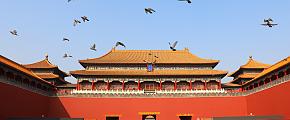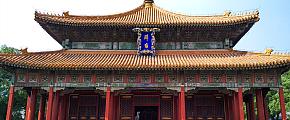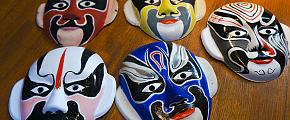Forbidden City in Beijing
Beijing's fabulous Forbidden City is the large palace complex in the world, definitely the No.1 tourist attraction included in all Beijing tour itineraries. Construction of The Forbidden City began in 1406 during the reign of the third emperor of the Ming Dynasty (1368-1911), Emperor Yongle. Before Emperor Yongle moved the capital it was located in the city of Nanjing in Jiangsu Province. There are many theories as to why he decided to move his capital to Beijing. The most popular theory was that when he was the crown prince, Yongle was in charge of the Beijing area, and being fond of the area he decided to move the capital there. The new capital city was built around The Forbidden City. Beijing was built with an axis line that ran north to south and through the center of the Forbidden City. The Chinese name for The Forbidden City when it was home to China's Emperors was "The Purple Forbidden City", it is called the Palace museum today. The Forbidden City was the imperial palace until 1911 when the last Emperor of the Qing Dynasty (1644-1911), Emperor Xuantong, gave up his throne. He was allowed to remain in The Forbidden City until 1924. In 1925 The Forbidden City was turned into The Palace Museum to save the buildings and their treasures in perpetuity.
 The Forbidden City
The Forbidden City
Most visitors to The Forbidden City are immediately overwhelmed by not only the scale of the palace but of the grandeur of it. They find it hard to believe that such an extraordinary place could be built for one man. Very little of the original Ming Dynasty Palace exists now. During the Qing Dynasty, especially during the reigns of Emperor Kangxi and Qianlong extensive remodeling was done. Colors during China's feudal reigns buildings needed to meet strict guidelines as to size, color, and even roof style. The Forbidden City is a prime example of this. Almost every roof in The Forbidden City is covered with golden tiles. Only the Emperor and temples he deemed worthy were allowed to use golden tiles. The roof structures also denote the importance of the building. The number of hips the roof has and protective animals on the corners of them follow strict guidelines. The size of rooms and the number of posts, windows, doors, and even steps were strictly enforced. According to Taoist tradition, women are even numbers and men are odd numbers. Since the number 9 is the highest single-digit odd number, it was reserved for the emperor, so most things in The Forbidden City come in sets of nine.
There were nine gates on The Forbidden City's central Axis. One of them is no longer in Existence. Going from South to North they are The Great Qing Gate, The Gate of Heavenly Peace (Tiananmen), The Upright Gate, The Meridian Gate, The Gate of Supreme Harmony, The Gate of Heavenly Purity, The Gate of Imperial Peace, and The Gate of Divine Prowess. The Great Qing Gate was located where the Monument to the people's heroes is today. Each gate has an odd number of openings. The center was to be used only by the Emperor, the next two were for high officials, the next set was used by the royal family, and the next was used by others. Each has its own unique features and uses.
 Meridian Gate
Meridian Gate
The Forbidden City is split into two parts, the Outer Court and the Inner Court. The Outer Court is where all political affairs were attended to and the Inner Court is where the Emperor and his Empress, wives, concubines, and wives of the former Emperor lived. The entire palace radiates from a central axis. The central axis and the gates located on it were only allowed to be used by the Emperor himself. There were only two exceptions: one is on the Emperor's wedding day when the Empress entered the palace by the central axis, and the second is during the imperial examinations when the number one scholar was allowed to walk down the central axis to leave The Forbidden City.
The three main halls of the Outer Court are built on a magnificent four-tiered dais made of white marble and covered with dragon waterspouts and dragon and phoenix balustrades. The hundreds of dragon heads on the dais are designed to be more than just decorations. They are waterspouts that are ingeniously designed to spit water during heavy rainstorms. The three buildings sitting on the dais are the Hall of Supreme Harmony, the Hall of Complete Harmony, and the Hall of Preserving Harmony. The Hall of Supreme Harmony is the highest building in The Forbidden City. It was used for grand ceremonies, major festivals, and the Emperor's wedding. It is the most commonly seen image from The Forbidden City. The Hall of Complete Harmony was where the Emperor would change clothing and wait before heading to the Hall of Supreme Harmony. The Hall of Preserving Harmony was where the Empress would meet with officials during her birthday and major festivals. It was also used to rehearse major ceremonies and for the top students of the imperial examinations.
On the north side is one of the largest stone carvings in China. It is carved from a single piece of marble. It is the walkway for the Emperor to climb the dais from the Inner Courts. It is beautifully carved with relief images of dragons playing amongst the clouds. The stone is almost 17 meters long and weighs 250 tons. These three main buildings are also known as the three main throne rooms. The Forbidden City features dozens of thrones, but none are as beautiful or hold a sense of power as the ones in these buildings.
Located in the Inner Court, the personal areas of the Emperor are three main halls. Located on the central axis, the three main halls although spectacular are small and more informal than the ones in the Outer Court. The three buildings are built on top of a single-tiered dais. The three buildings are the Palace of Heavenly Purity, the Hall of Union, and the Palace of Earthly Tranquility. The Palace of Heavenly Purity is the largest of the three buildings and was once the bedroom of the Emperor all through the Ming Dynasty and for the first two Emperors of the Qing Dynasty. It was then used by the Emperor as an audience chamber for meeting with the Grand Council and for banquets. The middle and smallest building of the three is the Hall of Union. The square hall has a huge golden finial on top of it which was reported to have been seen shining in the sunlight for miles around. The Hall housed the twenty-five Imperial Seals of the Qing Dynasty as well as the official clock for the entire palace. Originally a water clock was used and finally a spring wound clock, both of which are still located inside. The Palace of Earthly Tranquility which was originally the bedroom of the Empress was later used as a shamanistic shrine and one of the side rooms turned into the wedding chamber for the newly married Emperor and Empress. The wedding chamber is still decorated from the time of Emperor Guangxu's wedding.
The Forbidden City has several Imperial Gardens located within its walls. The largest is known as the Imperial Garden. It is located in the far north of The Forbidden City in the Inner Court section of the Forbidden City. The garden is a unique example of an imperial garden. The west and east sides mirror each other in the building layout. The garden is filled with ancient cypress trees and beautiful rockeries. One feature usually missed by visitors is the pathways. They are made of pebbles and are created into beautiful pictures. The garden is very beautiful and quite peaceful which is a testament to its design because it is always crowded with people. There are many pavilions to rest in and water features filled with large koi fish. Another garden in The Forbidden City that must be noted is known as Qianlong's Garden. It was part of the complex in the far eastern section of The Forbidden City built by Emperor Qianlong for his retirement. He pledged that he would not reign longer than his grandfather Emperor Kangxi whom he greatly admired, so he built the palace complex and garden for his retirement.
The garden although built in a very narrow area seems quite sprawling. It is filled with beautiful rockeries and pavilions. One interesting building features a small twisting manmade river built into the stone floor. There is an ancient Chinese poem that talks about a time when during the Tang Dynasty a group of scholars got together to drink alcohol and compose poems along a river. The alcohol cups were floated down the river and whichever scholar it stopped by had to compose a poem on the spot or forfeit by drinking the alcohol. The miniature river in Qianlong's Garden recreates this scene. Emperor Qianlong being very fond of composing poems would float alcohol cups down the little river and the ancient scene was brought to life. There is one more garden located in the Outer western section which was built for the wives of the previous emperor to live. It is burnt to the ground in the early twentieth century and is currently undergoing a major restoration which will someday be open to the public. It was considered to be the most beautiful garden in The Forbidden City and its reopening is being looked forward to.
The palaces and halls located inside The Forbidden City are each filled with priceless treasures. The greatest emperors of the Qing Dynasty were avid art collectors and historians. Having the power and the money to acquire the greatest masterpieces in Chinese history, they amassed huge collections of art and filled their palace with them. Everything in the buildings, not to mention the buildings themselves is made of the finest materials. The wood structures are made from rare namu wood, the posts and rafters are covered with gold leaf, and even the tiles in the Hall of Supreme Harmony, crafted in Suzhou, are reported to have taken ten years to produce and cost their weight in gold. Nothing was skimped in the building and decorating of The Forbidden City.
The Forbidden City was designed to show the power and status of "The King of Heaven". It is impossible for a visitor to see everything The Forbidden City has to offer with just one visit. It was and remains a place of impressive beauty. It was designed to instill a sense of wonder in visitors and even in this modern age, it still has the capability to do just that.
Quick Question
What Our Clients Say
SUBSCRIBE TO WIN A FREE TOUR
Subscribe to our newsletter for a chance to win a free 7-day Morocco tour! And more insider travel news, exclusive offers, and inspiration will be sent straight to your inbox.






